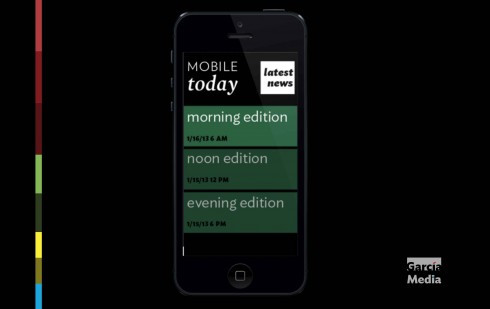TAKEAWAY: I continue to prepare for my presentation at the Nordic Media Festival conference in Bergen, Norway this week. What a difference a calendar year makes! As I take a look back at a similar presentation I did for the group in 2012, it’s like rewriting a book. TODAY: Those smartphones and the potential they hold for newspapers.


It’s one of those statements that mesmerize: there are more mobile phones than people in the globe.
It’s also difficult to be anywhere in the globe without seeing people all around us holding on to a phone, carrying on conversations, reading text messages, consulting a map for directions and, of course, reading.
It’s also quite visible to anyone with young children around them, that mobile phones are the toy of choice.
So, it should come as no surprise that phones are gaining tremendous attention on the part of media publishing houses worldwide as they fortify their digital offerings.
The phone is it
To me, of the four members of the media quartet (phones, online, print and tablet), it is the phone that holds the biggest promise. We all have one, it is right there in your pocket, your briefcase, or, most usually, right in your hand.
So far, newspapers and mobile phones have a healthy, not very complicated, relationship. Information flows freely and almost automatically into the phone. Alerts sound the bell when there is breaking news,especially during sports events. It’s all nice and easy, and users welcome it.
Today, however, the real evolution and revolution of mobile telephones is in its infancy but taking off at rapid speed.
We are likely to begin seeing more curated editions aimed at the phone in your hand. While the constantly updated information will continue to flow into your phones, we will also see more specially created “news moments” at several intervals during the day: the morning wake up call (what happened in your world while you slept), the lunch time recap (if you were too busy working, this is what’s transpired, complete with some good videos and photo galleries to look at while you munch on your sandwich), and then a commuting time edition (prepare yourself for the evening and the day ahead).
Phone editions
I forecast that these editions will be personalized, and will reach out to the cult of personality with a newspaper’s bloggers, columnists and other celebrities appearing to tell us what’s going on. Audio will play a key role in these phone editions as well.
Advertisers will be right there to capitalize on our fascination with the phone and its offerings.
And, I predict, users will be willing to pay for something that offers good content customized for the phone, along with service items and which is right there in that first platform we come in contact with before we even brush our teeth in the morning.
For more information about the Nordic Media Festival conference, May 8-10
Program and speakers
http://www.nordiskemediedager.no/om-mediedagene/nordic-media-festival/
Previous blog posts about presentation for Nordic Media Festival

Preparing a presentation allows for some introspection
https://www.garciamedia.com/blog/articles/preparing_a_presentation_allows_for_some_introspection
Creating a new tablet edition? Newsy and pictorial may be the way to go
https://www.garciamedia.com/blog/articles/pcreating_a_new_tablet_edition_newsy_and_pictorial_may_be_the_way_to_go_p
Tomorrow in TheMarioBlog:
The vital importance of social media for journalism today
Interview with Mario
A few months ago I had the honor of being interviewed for Contratapa, a media magazine published by the University of Navarra, Spain, and its School of Communications. Now the digital magazine is available.
In what is an unusual, but interesting, way of conducting an interview, the editor of the magazine asked 12 contemporary Spanish media designers and artists to submit questions for me.
Some were tough as in: Of all the projects you have completed, do you have any favorites?
My answer:
While I have no favorites, there are three that have impacted me for the scope of change and evolution—The Wall Street Journal, Die Zeit (Germany) and El Tiempo (Colombia)
The interview, in Spanish, is available here: